(Photo by Juan DeLeon/Icon Sportswire)
When Lance McCullers is pitching well, as he did on Tuesday, things like this happen:
[gfycat data_id=”UnevenVagueBanteng”]
McCullers is a beautiful thing to watch when he’s on. With his infamous curveball, he will manipulate hitters at an ace level. We all know the injuries and consistency problems are holding McCullers back from developing into that ace. In 2016 and 2017 combined, he failed to throw 200 innings. Despite the often disappointment, McCullers has placed himself in historic levels recently with his ability to dominate two categories: strikeouts and ground balls.
The ability to strikeout opposing hitters at a high rate is a prized ability and something that generally leads to success. Inducing ground balls is a less so prized, but certainly appreciated, ability of a pitcher. Ground balls are not as much a key to success as strikeouts. In 2017, Dallas Keuchel led the league in ground balls, Marcus Stroman was second, and … Luis Perdomo was third. Two good pitchers and one horrendous one. On the other hand, the strikeout rate leaders were Chris Sale, Max Scherzer, and Corey Kluber. Whiffing hitters is a more valuable skill than getting rollers on the ground, but at its simplest level, a ball in the air is more likely to land for a hit than one on the ground. Especially when considering extra bases.
Since the start of 2016, I plotted strikeout and ground ball rates for every starting pitcher (min 200 innings), with McCullers in red:
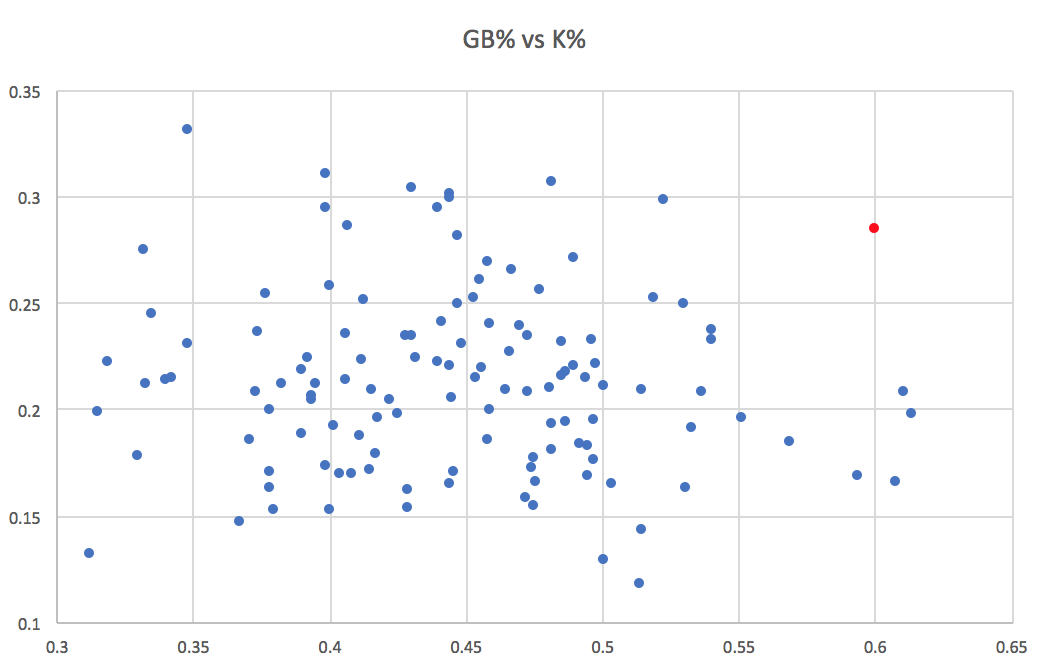
McCullers sets himself apart from most in this plot. He is not an outlier in each individual category, but his ability to excel in both places him in a company of his own. Now, let’s go back further in history. I combined what McCullers has done in his last 220 innings pitched (start of 2016) and classified that as one season. Since 2002, I calculated the z-score (deviation from average) for GB% and K% for every individual starting pitching season (min. 100 innings). They are plotted as well, with the top five total z-scores being tagged:
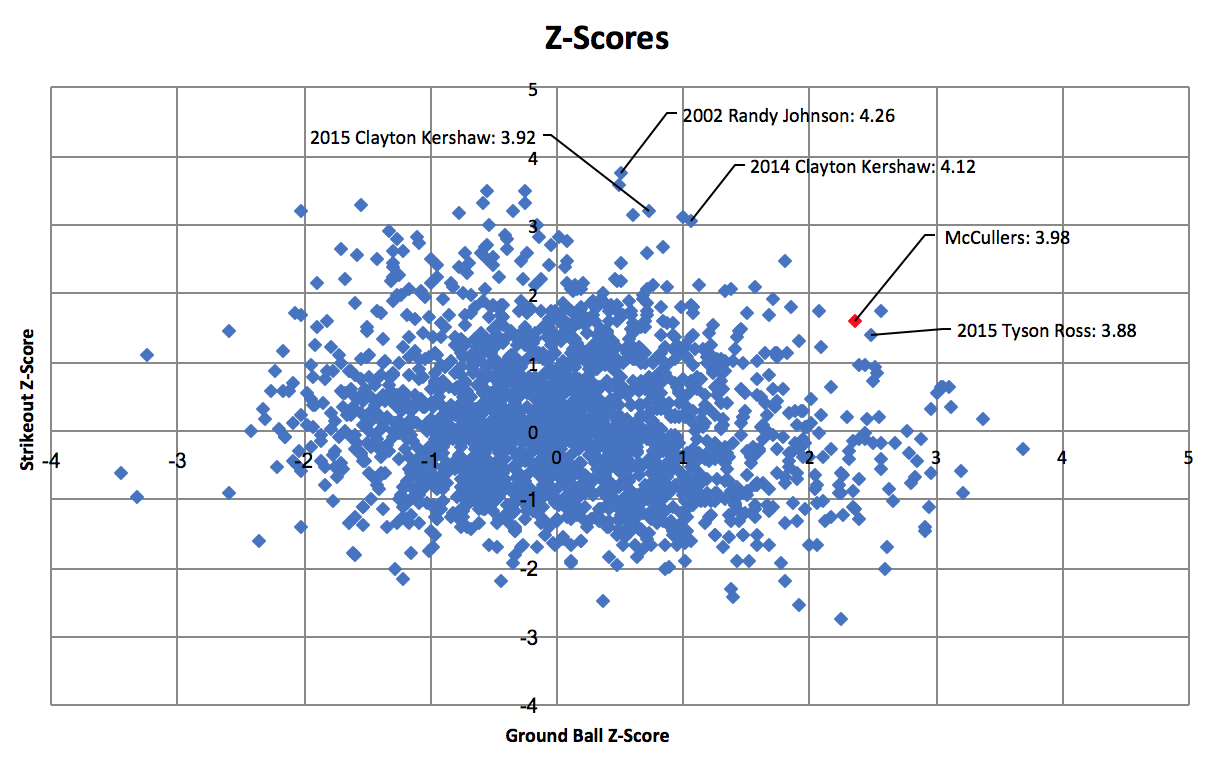
Out of 2115 such seasons, the recent work of McCullers again finds itself as an outlier. His last 220 innings have produced the third-largest total strikeout and ground ball score above average in the last 17 years. His company in the top five includes two prime Clayton Kershaw seasons, a Randy Johnson Cy Young year, and a Tyson Ross (remember him?) season in which he produced a 2.98 FIP. The Kershaw and Johnson scores are not quite similar to McCullers, though, as they were absolute strikeout artists. The Ross season, though, is strikingly similar:
| Player | K% | BB% | GB% | FB% | LD% | ERA | FIP | xFIP |
|---|---|---|---|---|---|---|---|---|
| McCullers | 28.5% | 10.1% | 60.0% | 19.9% | 20.1% | 4.00 | 3.08 | 3.01 |
| Ross | 25.8% | 10.2% | 61.5% | 19.9% | 18.6% | 3.26 | 2.98 | 3.15 |
With the numbers Ross put up in that year, both surface and peripheral, you can see the roadmap that this combination of skills could lead to. The pairing of whiffs and low-success contact is one that will almost undoubtedly produce good results. In recent history, only 2015 Ross has come close to matching McCullers in both categories. They are the only players since 2002 with both strikeout rates greater than 25% and a ground ball rate north of 60%. In fact, only one other player has even achieved at least 25% and 55%, with Felix Hernandez doing that in 2014. What about McCullers makes him so adept at both?
We know it begins with the curveball. McCullers is a curveball over fastball pitcher. He works in a changeup sporadically, but the primary focus is the former two pitches. He doesn’t just have two pitches, though. McCullers uses his curveball with incredible versatility, and if you watch an entire start from him, his curveball can look wildly different at all times. The pitch constantly looks like multiple pitches. Here is his curveball heat map since 2016 against left handed hitters:
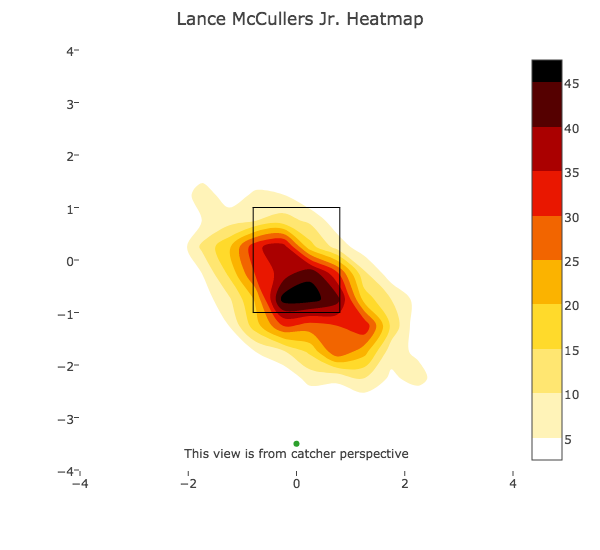
And the curveball heat map against right handed hitters:
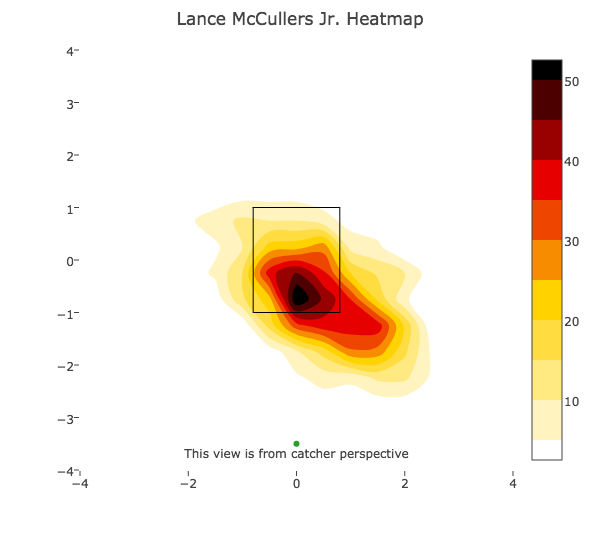
These “hot” zones of these heat maps are stretched all over the place. Conventional wisdom says that this is because wild pitching and lack of control. Pitchers generally have certain spots they like to locate a specific pitch. The tighter the location, the better indication of control. Take Rich Hill, who has thrown the second most curveballs since 2016, and look at his location against right handed hitters:
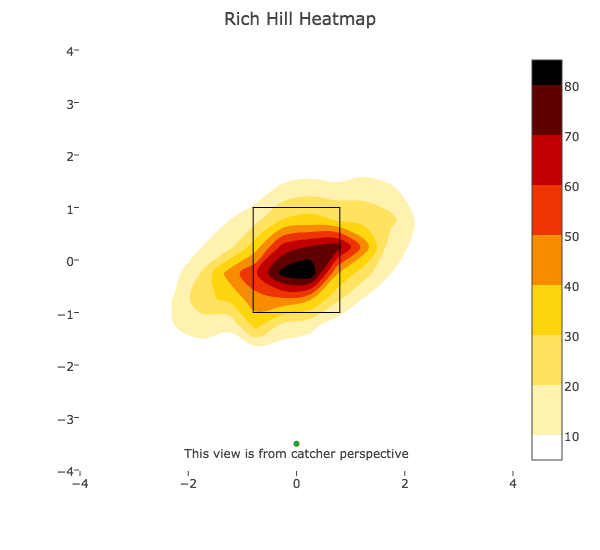
The hot zone is significantly tighter for Hill compared to McCullers, but as the results of the pitch indicate, this is not because McCullers cannot command the pitch. He pitches all over because he chooses to pitch all over. With a lack of a strong third offering, McCullers has to switch up the looks of his curveballs. This enables him to generate whiffs and soft contact on the pitch at an elite level. Take a sequence from Tuesday night against Kyle Seager, a game in which McCullers stuck out 11 and induced 8 ground balls on 11 balls in play:
[gfycat data_id=”ShamelessBountifulBronco”]
McCullers places two curveballs on the outside of the plate, with a changeup in between. With most curveballs in a two strike count, righties will try to bury that pitch to a left handed hitter. Instead, he leaves it right on the edge, where Seager is forced to swing but at a pitch he can do nothing with. We see a ground ball that he so often induces with his curveball. Now, the next time McCullers faces Seager:
[gfycat data_id=”ImpishGlitteringCobra”]
After going up and away twice against Seager in the first at-bat with his breaker, McCullers comes back to open the count with another curveball, but this time leaves it much farther inside and at the knees. Then he puts Seager away with this:
[gfycat data_id=”UntriedFluidAnura”]
Ahead in the count with two strikes, he comes back with a similar pitch that he opened the count with, but buries it even lower for the strikeout. Notice something here, and this is what I am talking about when I say that McCullers curveball is not just one pitch. To open the count, when trying to steal a strike, he fires in an 84mph curve that has the more typical looping action of a curveball. When trying to close out the sequence, he throws an 87mph that does not loop whatsoever and bites significantly harder. This is wholly intentional. McCullers ability to manipulate his curveballs cannot be overstated. Velocity, location, break, etc. will all change throughout a game. With a pitch that has so much raw stuff, the way he can command and alter his curveball makes it difficult for hitters to contact and barrel up. Even though opponents know a breaker is likely coming, they are constantly on their toes with no idea where it may be next. This generates tons of poor swings that either whiff or weakly hit the ball into the ground. Since 2016, McCullers curveball ranks 6th in whiff rate and 18th in ground ball rate among starters. Considering he heavily outpaces the league in usage, that is incredible.
His curveball is the strikeout getter and ground ball getter, but McCullers also possesses an incredible ground ball heater that consistently sits at 95+mph. Similar to the prowess of his curveball, the pitch ranks 5th in ground ball rate among starters in the same time period. If you want to talk about the raw stuff of his curveball, the fastball possesses similar filth. Another example from Tuesday night:
[gfycat data_id=”EmbarrassedRareBluetonguelizard”]
McCullers does not locate the pitch all that well, but his fastball rides in so hard at 96 mph that after starting off the plate, it moves far enough inside to jam Nelson Cruz and break his bat. He did the same thing to Jean Segura:
[gfycat data_id=”BlankFrayedFlatcoatretriever”]
The pitch bends over the middle of the plate, but with incredible movement and velocity, Segura does nothing with it.
However, this also epitomizes the inconsistencies of McCullers. Fastball command is always the topic of his success. He has proven the raw stuff and command of his curveball, and the stuff is proven with the fastball, but a lack of precise location has limited him from the stuff materializing in consistent excellence. Despite these shortcomings, McCullers peripherals to date suggest one of the top pitchers in the league, when healthy. Whether the results have been there or not, though, he has proved to consistently be able to achieve a combination of two things that is unrivaled by anyone else in the league. There are guys who strike out more hitters than McCullers, and there are guys who induce more ground balls than McCullers. But there is no one who has done both at the level he has. Currently, and in the past few decades. McCullers may never develop the health and consistent fastball command that the entire league hopes. Regardless, when he takes the mound, hitters are going to whiff and hitters are going to put the ball on the ground at an incredible rate.
